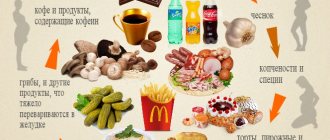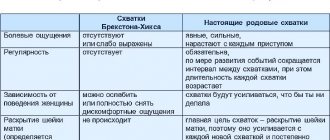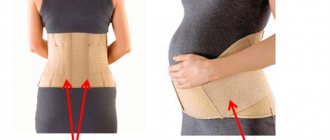What is toxicosis and gestosis in pregnant women?
For many, the word “toxicosis” is strongly associated with pregnancy, despite the fact that this word actually means poisoning (intoxication) with harmful substances entering the body from the outside or produced by the body itself. And if toxicosis of pregnant women in the early stages is a completely natural phenomenon, then there is another type of intoxication, which is called gestosis of pregnant women. It is talked about much less often because it is a complication of pregnancy and does not affect every pregnant woman.
What is the difference between gestosis and toxicosis of pregnant women? Let's figure it out.
What is pregnancy toxicosis?
In the first few weeks (up to 16 weeks), the body of a pregnant woman is reconstructed. Metabolism and hormonal levels change, and the load on all organs and systems increases. In addition, a special pregnancy center is formed in the brain, which is adjacent to the areas responsible for vomiting, nausea, and salivation. And since the pregnancy center is active, neighboring areas of the brain are also irritated. Toxicosis of pregnant women in the early stages becomes an indicator of these changes, causing nausea and vomiting, a general state of lethargy and weakness.
Toxicosis of pregnant women in the early stages does not develop in all pregnant women, but quite often. There are no clear signs that will tell whether the expectant mother will have toxicosis or not. A woman who is not familiar with toxicosis during her first pregnancy may encounter it in her second, and vice versa. Often toxicosis can be caused by odors or a particular type of food.
Toxicosis comes in varying degrees of severity: mild, moderate and severe. If vomiting occurs no more than 5 times a day, then such toxicosis is classified as mild. But problems with the gastrointestinal tract or pathology of the gallbladder and pancreas can increase toxicosis in pregnant women, which ultimately leads to undesirable consequences: exhaustion, disturbance of water-salt balance, lack of normal nutrition of the fetus, its oxygen starvation, which can lead to developmental pathologies . Severe toxicosis requires mandatory hospitalization, since in this situation the life of the expectant mother is in danger.
What is gestosis?
Preeclampsia is fundamentally different from toxicosis of pregnant women, first of all, in the time of occurrence. Gestosis in pregnant women develops in the later stages, while toxicosis develops in the first trimester and ends at 12–16 weeks.
The cause of gestosis is completely different from toxicosis in the early stages. In Russia, doctors call gestosis a condition caused by an increase in blood pressure in the expectant mother. These conditions are associated with accompanying sensations - weakness, dizziness, vomiting and nausea, cramps and a general feeling of poisoning, as the kidneys can no longer cope with the load. Although from a certain point of view, gestosis is also toxicosis in late pregnancy, but these are very different types of “poisoning”.
37th week of pregnancy for baby
At the 37th week of pregnancy, the baby’s height is approximately 48 cm, and his weight is 2,600 g. Externally, the fetus is almost no different from a newborn; all facial features are developed, and cartilaginous tissue is clearly visible. The accumulation of subcutaneous fat at this stage of pregnancy makes the body contours softer and rounder. The baby’s skin gradually smoothes out, it is no longer as pink as in the previous weeks of intrauterine development, and the integument gradually becomes lighter. The baby's body is still abundantly covered with lubricant, but the amount of vellus hair decreases noticeably, vellus hair remains only on the shoulders and back, and in some babies it disappears almost completely.
This week the accumulation of fatty tissue continues. It reaches a maximum of 15% of the child’s total body weight. It is difficult to overestimate the importance of adipose tissue for newborns; it is this tissue that protects the child from overheating or hypothermia, since the baby’s thermoregulation system after birth is not yet sufficiently formed and continues to develop in the first months of the little person’s life.
At this stage, not only the volume of subcutaneous fat increases, but also the muscles and skeleton intensively develop. The child constantly moves his arms and legs. These unique workouts help increase muscle mass. The baby also makes rhythmic breathing movements that strengthen the intercostal muscles and diaphragm, preparing the respiratory organs for childbirth.
Pregnant woman at 37 weeks
As the due date approaches, pregnant women begin to notice the appearance of their precursors, that is, certain signs and changes that occur under the influence of hormones. A woman’s body is preparing to give birth to a child, progesterone gives way to the dominant role of the birth hormone estrogen, and the pregnant woman’s well-being changes.
From the 37th week, expectant mothers may observe the following changes:
- slight loss of body weight;
- reduction in abdominal volume;
- the appearance of training or “false” contractions and an increase in their intensity;
- discharge of mucus from the cervix.
The nature of the stool changes, it becomes weaker, aching pain in the lower back of varying intensity may appear, and the fundus of the uterus descends. The woman notes some signs on her own, others are observed by the gynecologist during a routine examination.
Precursors do not appear in all women. Some expectant mothers notice only some of the symptoms listed above, while others observe signs of impending labor not two or three weeks before the due date, but just a few hours. Both the appearance of precursors at the 37th week and their absence are normal and depend on the individual characteristics of the woman’s body.
This week, the female body is intensively preparing for the birth of a child. If the fetus is positioned correctly, head down, it gradually lowers, goes to the lower part of the uterus, presses it to the body and bends its limbs, intuitively taking the most comfortable position for passing the birth canal. The consequence of fetal movement is prolapse of the uterine fundus. The abdomen lowers, the pressure on the diaphragm decreases significantly, the pregnant woman can breathe easily, and the shortness of breath that plagued her in the previous weeks disappears. The pressure on the stomach also decreases, heartburn, a feeling of heaviness after eating and other unpleasant sensations disappear. Moving your baby can put pressure on your bowels and bladder. A pregnant woman at this stage often experiences the urge to urinate and may suffer from frequent loose stools. The reason for frequent bowel movements is not only the mechanical effect of the uterus on it, but also an increase in the content of estrogen in the body, hormones that promote the excretion of fluid. At the 37th week, the expectant mother can have bowel movements up to 3-4 times a day and at the same time observe significant dilution of the stool.
An alarming sign or part of the norm?
Diarrhea at 38 weeks of pregnancy can make the expectant mother anxious and worried. The entire period of bearing a child is responsible and important. The kind of life a pregnant woman leads, how she eats and what emotions she experiences determines how her baby will be born. Should I worry about loose stools at 38 weeks of gestation?
In fact, diarrhea before childbirth is a companion for many women. Mothers in labor noted that they began to experience this unpleasant phenomenon approximately 2 weeks before the onset of labor. This is very individual, since in some women this symptom did not appear at all or developed a day or two before they went to give birth to a child.
38th week of pregnancy: development of the unborn baby
At the 38th week, the fetus is fully formed, so childbirth at this stage is no longer dangerous for both mother and baby. The weight of the fetus is about 3 kg, but this figure can vary significantly between babies; the weight depends on the individual characteristics of the mother and child, body structure and other factors. The body length of a newborn is approximately 50 cm.
All organs and systems at a period of 38 weeks are characterized by physiological and morphological maturity, they are completely ready for work. At this stage, the baby is preparing for childbirth, making breathing movements and preparing the intercostal muscles for breathing. The lung tissues are washed with amniotic fluid, which helps maintain the required level of surfactant covering the baby's lungs from the inside. All elements of the respiratory system are ready for use. With the first breath after birth, the alveoli begin to transfer oxygen from the air into the blood, gas exchange occurs, and the respiratory and circulatory systems begin to work intensively.
What to do?
If diarrhea begins shortly before giving birth, you need to prepare for departure to the maternity hospital. This does not mean that you should leave everything and just wait for the process to begin. It’s better to calmly go about your normal activities, but you should pack your things in advance.
The most dangerous complication of diarrhea is excessive fluid loss, or dehydration. To prevent this, try to drink more fluids. This will not harm either the woman or the unborn child.
In cases where intestinal upset is actually caused by impending childbirth, it is not dangerous and there is no point in taking any medications to stop it, because it is a natural process. It is important to tune in to a positive wave, stock up on beneficial emotions and think about the future.
Pregnant woman
The body of a pregnant woman continues to actively prepare for the birth of a baby, the content of estrogen rapidly increases, and the level of progesterone decreases significantly. Changes in hormonal levels help soften the tissues of the birth canal and cervix. Throughout pregnancy, the lumen of the cervical canal is closed by a plug of thick mucus, which protects the baby from infection, and the uterine cavity protects against the penetration of microorganisms hazardous to health. In the last weeks of pregnancy, the consistency of the mucus changes, it becomes more liquid and begins to gradually flow out. In some women, the mucus disappears gradually, while in other women in labor it comes off simultaneously. The discharge resembles colorless egg white in its consistency and appearance. Sometimes the mucus is pinkish, brown or yellow. The removal of the plug is painless; the woman may experience a slight feeling of discomfort in the lower abdomen. The removal of the plug may be signaled by more abundant vaginal discharge than during the entire pregnancy.
A woman should carefully monitor the color and volume of discharge, since too much colorless discharge may indicate not only the passage of the plug, but also be one of the symptoms of leakage of amniotic fluid. Indicator pads and amniotests or test strips will help determine the cause of the discharge. The pads are sold in many pharmacies and can be easily used at home. If leakage of amniotic fluid is confirmed, you should immediately consult a doctor.
After the mucus plug comes off, you should avoid visiting the pool and swimming in open water, as the risk of infection for the child increases significantly. It is also necessary to exclude sexual contact.
39th week of pregnancy: what happens to the fetus?
At the 39th week, the child’s weight reaches 3,100-3,500 g, and his height is 50-52 cm. Height and weight indicators are very relative and can differ significantly. The baby is rapidly preparing for the most important test in his life - birth, which requires endurance and significant effort. During this period of pregnancy, the size and weight of the child’s adrenal glands, that is, the glands of the endocrine system, which are responsible for the human body’s response to stress factors, increase. It is the hormones adrenaline and norepinephrine produced by the adrenal glands that help the child adapt as quickly as possible to new temperature conditions, tactile, sound and light impulses.
All the baby's senses are developed at 39 weeks. Within a few moments after birth, the baby can focus his gaze, he reacts to bright light and moving objects, many scientists claim that newborns distinguish colors and see the faces of parents and doctors. In the last weeks of intrauterine life, the baby's hearing is also fully developed; after birth, he reacts to loud sounds and noise. A newborn baby can identify the basic shades of taste, recognize sour, bitter, sweet and salty.
In the womb, the baby is in an aquatic environment that minimizes contact. Immediately after birth, the baby experiences many tactile sensations; unlike intrauterine life, he feels the touch of his mother’s hands and diapers, towels, dressings and other materials. Babies especially like the touch of skin to skin, so in a modern maternity hospital, newborns are always placed on their mother’s stomach even before the umbilical cord is cut. The child adapts more easily to the new environment and feels protected. Placing the baby out has not only a psychological aspect, since it promotes the colonization of microorganisms from the mother’s skin onto the skin and mucous membranes of the baby, and increases his immunity.
Pregnant woman
In the last weeks of pregnancy, the expectant mother strives to prepare her apartment or house as much as possible for the arrival of a new family member. Scientists call this sign of impending birth nesting syndrome. Many women observe signs of the syndrome from the thirtieth week of pregnancy, but at the 39-40th week nesting reaches its maximum point. Pregnant women strive to do general cleaning and repairs, re-stick wallpaper and purchase many new things that, in their opinion, are simply necessary in the house. After giving birth, many purchases cause confusion. The reason for this behavior is an increase in the level of adrenaline and norepinephrine in the body. These hormones are produced by the adrenal glands; they are necessary not only for the woman, but also for the baby to prepare for the upcoming birth.
Why are colds dangerous during pregnancy?
Speaking about viral infections during this period, it is important to understand that in some cases consequences are possible for both the child and the expectant mother.
In the 1st trimester, the risk of negative effects on the fetus is highest. The placenta, as a natural barrier, has not yet been formed; viruses can enter the bloodstream and directly affect the embryo.
Among the most dangerous acute respiratory viral infections are influenza and coronavirus. Studies related to the effects of influenza during pregnancy suggest that the likelihood of developing deformities is influenced not only by the virions themselves, but also by the fever that occurs in response to their exposure.
In the case of ARVI in the 1st trimester, complications such as:
- development of severe defects in the fetus;
- termination of pregnancy in the early stages;
- the presence of a threat of miscarriage, which can persist for a long time.
In the 2nd trimester, the placenta is already performing its functions, and the baby’s main organ systems are already formed. At this time, infection can affect individual organ systems and prevents most viruses from harming the fetus. The exception is coronavirus. Studies conducted by French scientists confirm that it is able to penetrate the placenta and directly infect the fetus (vertical mode of infection).
In addition, coronavirus worsens the condition of the placenta: areas of inflammation, blood flow disturbances are found in it, and the size itself is smaller than normal.
When contracting ARVI in the 3rd trimester, the harm to the baby is associated with the initial state of health of the mother and the degree of damage to the placenta. If there are disturbances from the fetal site, negative consequences for the fetus are possible: the baby suffers from chronic hypoxia, and subsequently lags behind in physical development. Such a child may be born prematurely and have low weight.
And the pregnancy itself is under threat - in 3% of women with damage to the placenta due to ARVI, placental abruption with bleeding develops. This is a life-threatening condition that can cause the death of a mother or child. However, obstetricians-gynecologists are encouraging that chronic hypoxia and complications develop only when more than 50% of the placenta is affected; in other cases, the child does not suffer.
40th week of pregnancy: how is the baby developing?
40 weeks – full-term pregnancy. The weight of a child born at this period ranges from 2,600 g to 4,400 g, and his body length is 48-53 cm. These indicators are very arbitrary, since at 40 weeks miniature babies weighing 2,600 g and real heroes are born, whose body weight approaches 5,000 g. The body length of newborns can also vary from 45 to 55 cm.
Most women give birth at 40 weeks. At this stage, the baby is completely ready for birth; it meets all the parameters of a full-term baby. Before birth, the baby presses its arms and legs closely to the body, bends its head as much as possible and presses against the exit of the uterus. This position makes it possible to pass the birth canal with the narrowest part of the skull. During labor, with each contraction, the child gradually moves downward; he does not move in a straight line, but makes helical-translational movements, as if screwing into the mother’s birth canal. As the newborn moves forward and his head descends completely, the cervix opens completely. This is followed by pushing, that is, contractions of the uterus that move the baby along the birth canal. The baby's head gradually appears, followed by his body. Childbirth is a complex mechanism that is aimed not only at the safe passage of the birth canal by the child, protecting him from accidental injuries due to increased pressure, but also at preventing ruptures of the woman’s soft tissues.
Pregnant woman
The long wait to meet your unborn child is coming to an end; the 40th week of pregnancy is the last for most women. Every day the expectant mother’s anxiety increases, and the long wait affects her mood and well-being. Women strive to give birth to a child as quickly as possible, so that pregnancy and painful contractions become a thing of the past. Every pregnant woman dreams of meeting her baby, wants to hold him to her breast and stroke his tender head.
Many women, especially first-time mothers, worry that labor will begin unnoticed, but such cases are extremely rare. A woman feels the onset of labor, feels regular contractions that repeat at certain intervals and gradually increase, the time interval between them shortens.
Contractions may be preceded by prenatal rupture of amniotic fluid, which is observed in a certain percentage of women in labor. After the water breaks, contractions may be quite weak or completely absent. Regardless of the intensity of contractions, the release of water is one of the signs of the onset of labor and requires immediate contact with specialists and the woman’s hospitalization in a maternity hospital or hospital, since when the water breaks, the integrity of the bladder is disrupted and the risk of microorganisms dangerous to the baby’s health entering the uterine cavity increases. It is important that after the water breaks, the baby is born within a maximum of 10-12 hours.
A pregnant woman must properly tune in to childbirth, concentrate on the desired result and believe in her own strength, and complete the task intended for her by nature. The right psychological attitude and theoretical knowledge will help a woman become a mother, successfully go through all stages of childbirth and hold the long-awaited child to her heart.
When diarrhea threatens the health of mother and child
In some cases, diarrhea at 38 weeks of pregnancy can be serious. You should immediately go to the hospital or even call an ambulance if the following symptoms develop:
- severe stomach pain;
- nausea;
- vomit;
- temperature;
- water diarrhea;
- green or yellow stool;
- feces have a characteristic pungent odor;
- feeling of intense thirst.
We recommend: Causes and treatment of diarrhea in pregnant women - why is it dangerous?
The appearance of these symptoms indicates the presence of an intestinal infection. To maintain your pregnancy and give birth to a healthy baby, you need qualified medical care.
Persistent diarrhea
There is such a thing as persistent diarrhea. This problem is reported when diarrhea continues for more than 2 weeks.
The cause of intestinal disorder of such duration is viral infection. The problem requires qualified treatment, otherwise there is a high risk of developing fetal hypoxia, severe dehydration, deterioration of blood supply and even death.











